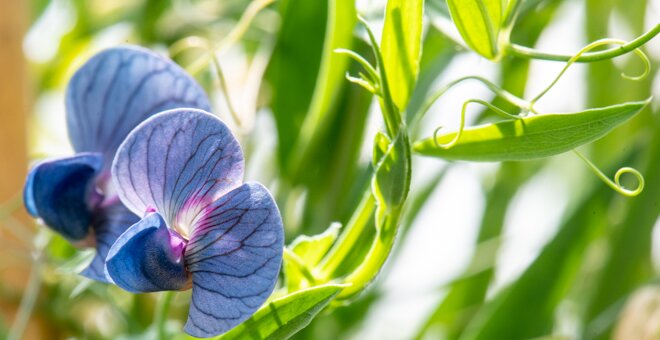CROP CHRONICLES: 14 June 2024
People say I’m a split personality. I’m tough and resilient. Droughts and floods mean nothing to me, and because of that I’m often the only crop left in the fields when disaster strikes.
People say I’m a life-saver. And yet, they also blame me for crippling the very people who depend on me most: poor subsistence farmers in rural areas far from the city.
Let me explain. In English, they call me grasspea. My scientific name is Lathyrus sativus. The word lathyrus is derived from a Greek word that referred to some kind of pea or bean, while sativus just means a plant that is cultivated. Lots of other crop plants are called sativus.
Europeans have been growing me for a long time, maybe 8000 years or so, according to some seeds found in the Balkans, but I was probably first cultivated before that in the parts of Turkey and Syria known as the Fertile Crescent. And because I am so useful, people took me with them to Asia and Africa. There’s even a rumour that the Queen of Sheba herself brought me home to Ethiopia after visiting King Solomon. To this day, Ethiopians eat grasspea seeds boiled, as nifro, roasted, as kollo, and as an ingredient in traditional sauces.
Clearly, then, people in many places have found grasspea useful and tasty. So what’s all this about crippling them?
Well, it’s true. I am blamed for a condition known as lathyrism, which is a kind of irreversible paralysis of the legs. It is caused by a substance called β-N-oxalyl-l-α,β-diaminopropionic acid — β-ODAP for short — although nobody understands exactly how it works.
The thing is, people only develop lathyrism if I provide more than about a third of the energy in their diet for longer than 3 to 4 months. That has happened when drought caused a famine, and I was the only thing left in their fields and the cheapest food on the market. Looking back, though, there haven’t been any cases during famines since 1999, when there was an outbreak in Northern Ethiopia. During that famine, lathyrism was much lower among people who received cereals as food aid. That is important.

So yes, I can be blamed for lathyrism, but it wouldn’t be a problem without crippling poverty and food insecurity, and I could help with that. Given that grasspea can already cope with almost anything the climate emergency can throw at me, my ability to tolerate and improve poor soils, withstand drought and flooding, and provide nutritious, high-protein food for people and livestock, could help reduce poverty and improve food security.
Scientists have gathered more than 8,000 different kinds of grasspea, split roughly equally between traditional cultivars — landraces collected from farmers’ fields — and wild samples that were not being cultivated.
Plant breeders make use of this wonderful diversity to develop new and improved varieties. One important direction for breeding is to increase productivity. Sure, I can survive under poor conditions, but given a good growing environment, yields go up from less than one tonne to more than five tonnes per hectare. Furthermore, it seems that I produce more β-ODAP when stressed by poor growing conditions, so improving the environment can help to minimise that problem too. Genes from my wild and weedy relatives contribute to better production, bringing with them resistance to fungal diseases like powdery mildew. Some varieties are also now resistant to parasitic plants that can devastate even a well-grown crop.

That troublesome toxin β-ODAP is itself in breeders’ sights. Among all the varieties of grasspea investigated so far, the highest concentration of β-ODAP is 130 times greater than the lowest, and breeders have succeeded in combining very low β-ODAP with higher yield potential and resilience.
From all I have said, you might think that it isn’t really worth a lot of effort to reduce β-ODAP. After all, people in Europe and elsewhere enjoy dishes containing grasspea with no ill effects. With a more varied diet, I am simply not a problem.
I admit I have a bad reputation in some quarters, but that is more the result of poverty and food insecurity than β-ODAP alone. Time to put my reputation behind me. The qualities that make me a reliable source of food in times of famine also make me an ideal candidate for an agriculture struggling to cope with the many threats of the climate emergency.
Did You Know?
- Scientific names: Lathyrus sativus
- Origin: Fertile Crescent, cultivated in the Balkan Peninsula ~8000 years BP
- Used and grown around the world: Estimated to be grown on 1.5 million ha and producing 1.2 million tonnes a year.
- Slow Food, which aims to safeguard foods on the edge of extinction, includes grasspea varieties in its Ark of Taste: guixes from Garraf in Spain, ciciruocculo of Licodia Eubea in Sicily, and a near relative, L. clymenum, from the Greek island of Santorini. In addition, the community of Serra de’ Conti in Ancona, Italy, is a Slow Food Presidium, involved in the traditional cultivation of its cicerchia to restore its place in the environment and on the market.
- Conservation: About 8,300 accessions are stored as seeds: 2557 in ICARDA genebank, 897 in the Australian Grains Genebank and 837 in the Ustymivka Experimental Station of Plant Production, Ukraine. About 2,310 accessions are safety duplicated in the Svalbard Global Seed Vault.
This story is part of Crop Chronicles, a multimedia campaign that uncovers the stories of the crops that feed the world, the people who grow them and the race to adapt them to a changing climate.
Related stories
Pre-Breeding Work With Grasspea and Finger Millet Gets a Boost
Two food crops prized for their nutritional value and ability to survive temperature extremes, drought and poor soil are now receiving the attention they deserve. A new project led by the Crop Trust will help improve the...
2 Oct 2019
2 Oct 2019



